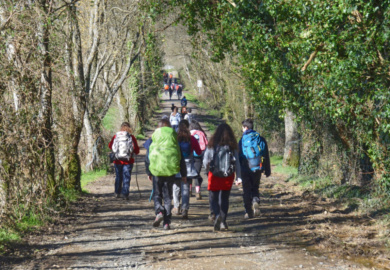We’re fortunate to live in the centre of a triangle that includes three scenic jewels, Exmoor National Park, the Blackdown Hills AONB (Area of Natural Beauty), and the Quantock Hills AONB.
Initially, our focus was on the most well-known of these three, Exmoor. But the longer we live here, and the more we explore further afield, the more we’ve come to appreciate what the other two have to offer. The Quantocks especially are a revelation that remain relatively undiscovered by people outside of the South West of England.
These are a few snapshots of the Quantock Hills, a selection of the sort of ingredients that keep drawing us back to discover more.
Electric Fyne Court
Our first foray into the Quantock Hills was for a wander around the woodland at Fyne Court, a National Trust property consisting of what’s left of the estate’s buildings and gardens, plus surrounding forest trails. One of the curious things about Fyne Court is it was once home to Andrew Crosse, a scientist who was an early pioneer in the use of electricity. It’s said he experiment on his friends, giving them electric shocks when they weren’t expecting them. His obsession with using lightning to create electricity resulted in him being known locally as the ‘Wizard of Broomfield,’ leading to stories that his experiments partly inspired Mary Shelley to write Frankenstein.
King Alfred and the Quantocks
After weeks of inactivity due to rainfall, the Quantock’s undulations were a training ground to get us match fit for creating a walking holiday on the island of La Palma, one of the steepest islands in the world. One route involved walking part of the Drove Road, a wooded thoroughfare once used by farmers taking livestock to market. The path is also known as King Alfred’s way as the King of the Anglo-Saxons marched his army along it en route to fighting the Viking invaders. Not far from the car park above Crowcombe is the macabre Dead Woman’s Ditch, so named because the body of a murdered woman was discovered here in 1789. Incidentally, some of the scenery around it is remarkably similar to the ancient laurisilva rainforests found on La Palma and its neighbouring western Canary Islands.
Magical Hestercombe House & Gardens
We’ve written a post specifically about Hestercombe House & Gardens, which you can read here. The gardens especially are quite wonderful, right up there with my favourites from around Europe. Partly that’s because they are full of interesting things to discover, like the quirky Witch House, a thatched shelter which has delighted visitors since at least 1761, with its gnarled, entwined branches giving it a distinctly magical appearance.
Enchanted Forests
On our last visit, we walked a circuit from Holford with a relation who was, coincidentally, staying there. Holford is a lovely little village that blends into the bushy forest, a verdant oasis below wild moorland. There are a couple of quirks in Holford. One is a dog pound dating from the 16th century that was built after a local huntsman was attacked and killed by his own hounds. The other is the ruins of a silk mill which was used in Bryan Adams’ video for the song Everything I Do. This can’t be checked as the original video has disappeared from YouTube. Kilve Beach also featured apparently. On that last visit, when we descended from moorland into forest, an adder slithered right across our path, adding a wow moment to the final stage of a superb walking route.
Each time we walk there, we are more and more impressed with what the Quantocks have to offer hikers. We’re a bit late to this party though. Back in the late 18th century, a certain William Wordsworth wrote this about the Quantock Hills:
That summer under whose indulgent skies,
Upon smooth Quantock’s airy ridge we roved
Unchecked, or loitered ‘mid her sylvan coombs,
Thou in bewitching words, with happy heart…






